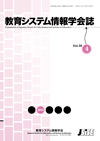26 巻, 4 号
選択された号の論文の7件中1~7を表示しています
- |<
- <
- 1
- >
- >|
巻頭言
-
2009 年26 巻4 号 p. 327-328
発行日: 2009/11/30
公開日: 2019/03/25
PDF形式でダウンロード (224K)
原著論文
-
2009 年26 巻4 号 p. 329-338
発行日: 2009/11/30
公開日: 2019/03/25
PDF形式でダウンロード (1561K) -
2009 年26 巻4 号 p. 339-348
発行日: 2009/11/30
公開日: 2019/03/25
PDF形式でダウンロード (1972K)
実践論文
-
2009 年26 巻4 号 p. 349-356
発行日: 2009/11/30
公開日: 2019/03/25
PDF形式でダウンロード (1474K) -
2009 年26 巻4 号 p. 357-366
発行日: 2009/11/30
公開日: 2019/03/25
PDF形式でダウンロード (811K)
解説
-
2009 年26 巻4 号 p. 367-376
発行日: 2009/11/30
公開日: 2019/03/25
PDF形式でダウンロード (3975K)
コミュニティ・プラザ
-
2009 年26 巻4 号 p. 377-382
発行日: 2009/11/30
公開日: 2019/03/25
PDF形式でダウンロード (2293K)
- |<
- <
- 1
- >
- >|
